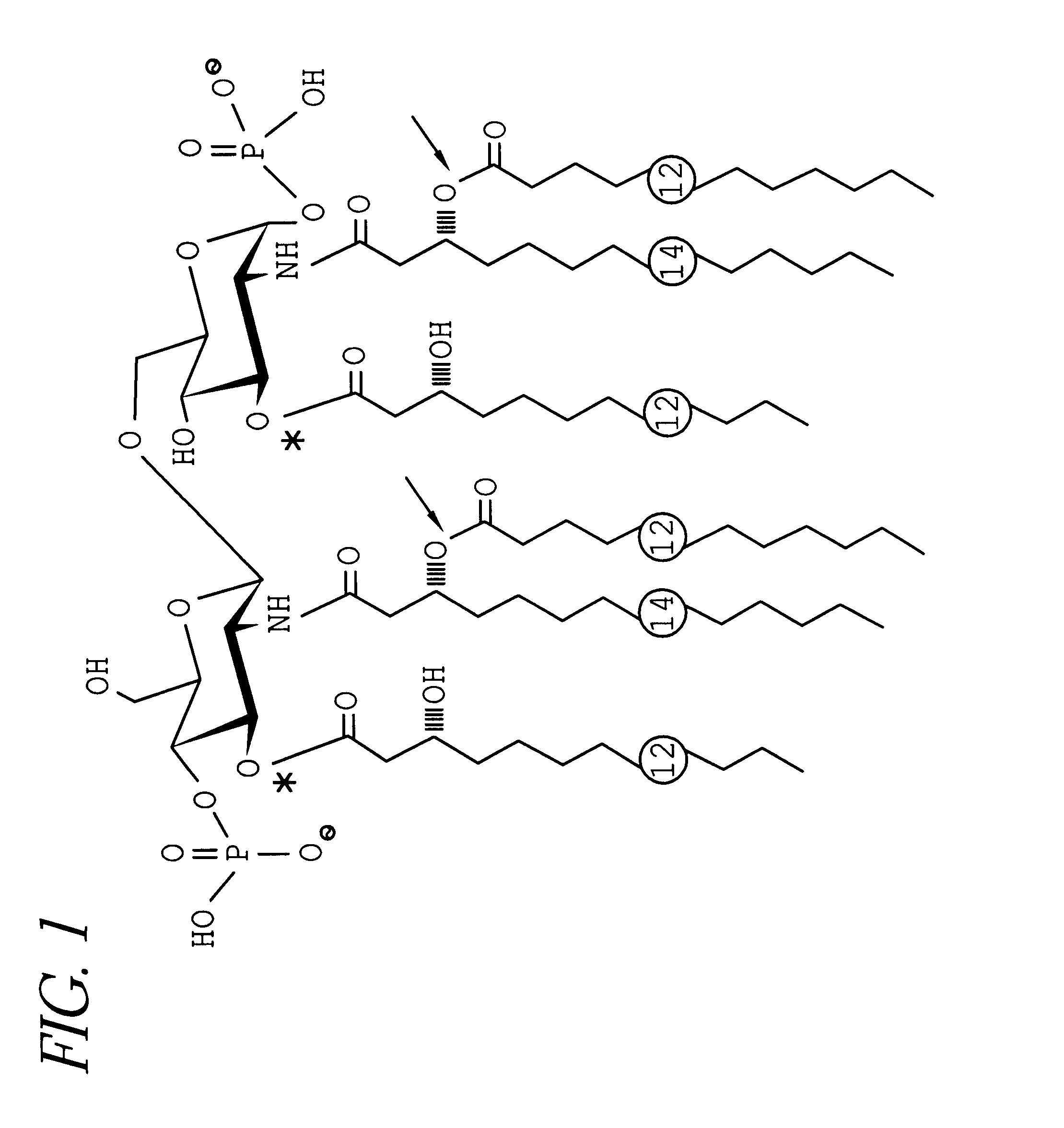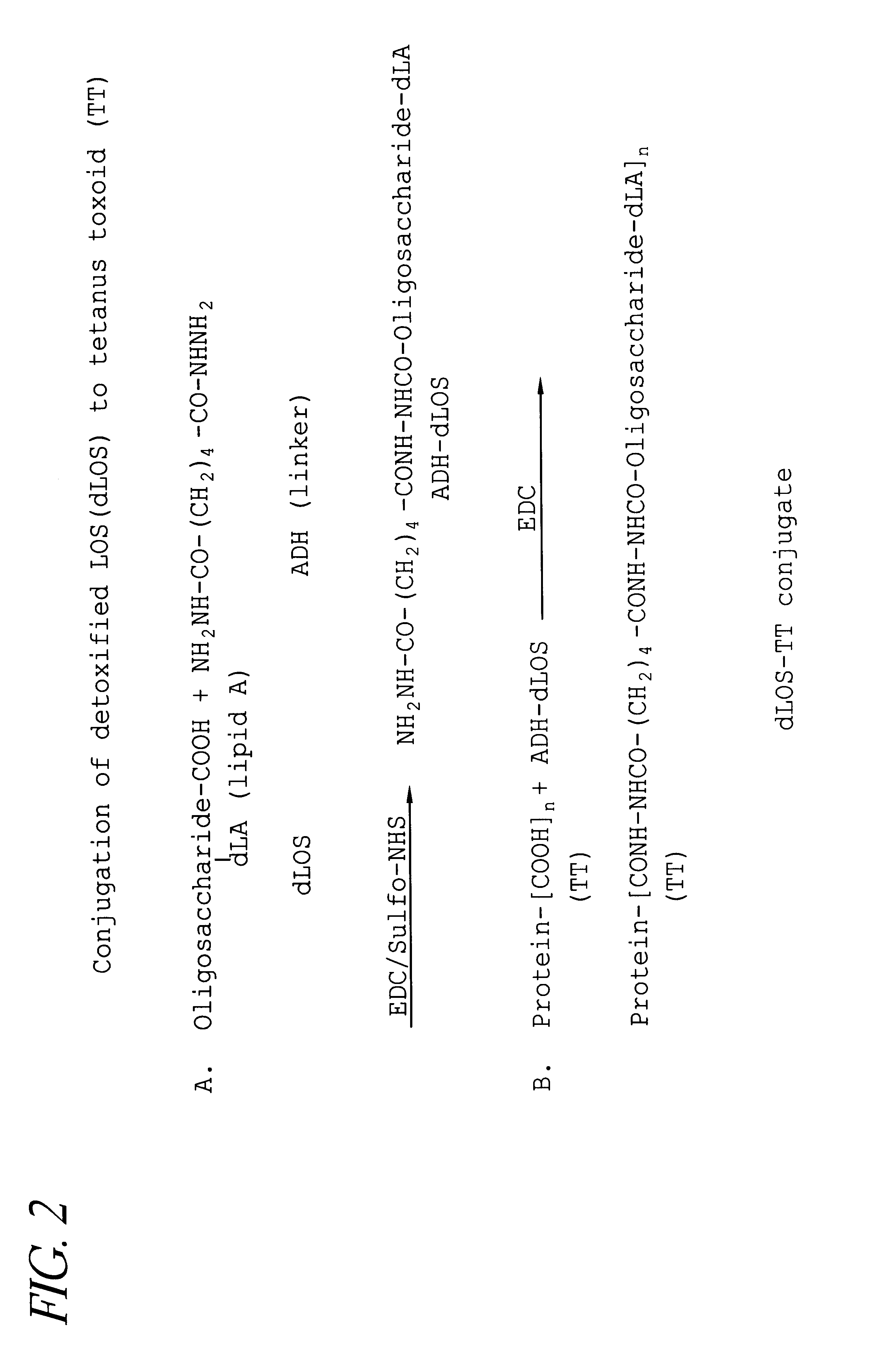Conjugate vaccine for Neisseria meningitidis
a vaccine and neisseria technology, applied in the field of conjugated vaccines for neisseria meningitidis, can solve the problems of poor immunogenicity of hydrazine-detoxified lps from shigella, unfavorable procedure, and inability to predict whether an los or lps detoxified by hydrazine treatment will be immunogeni
- Summary
- Abstract
- Description
- Claims
- Application Information
AI Technical Summary
Problems solved by technology
Method used
Image
Examples
example 2
Detoxification of LOS
LOS (160 mg), isolated as described in Example 1, was dried over phosphorus pentoxide (P.sub.2 O.sub.5) for 3 days, suspended in 16 ml anhydrous hydrazine (Sigma) and incubated at 37.degree. C. for 2 hours, mixing every 15 min. The solution was placed on ice, then added dropwise to cold acetone in an ice bath until a precipitate formed (.gtoreq.90% acetone). The mixture was centrifuged at 5,000.times.g at 5.degree. C. for 30 min. The pellet was washed twice with cold acetone, dissolved in pyrogen-free water to 20 mg / ml, and centrifuged at 150,000.times.g for 3 hours at 5.degree. C. The supernatant was lyophilized and applied to a 1.6 .times.90 cm SEPHADEX.RTM. G-50 gel filtration column (Pharmacia, Upssala, Sweden). The column was eluted with 25 mM ammonium acetate and monitored with a differential refractometer (R-400; Waters, Milford, Mass.). The eluate was assayed for carbohydrate content by the phenol-sulfuric acid method (Dubois et al., Anal. Biochem., 28:2...
example 3
Derivatization of dLOS
ADH was bound to the carboxyl group of the KDO moiety of dLOS to form AH-dLOS derivatives using EDC and N-hydroxysulfo-succinimide (sulfo-NHS) (Pierce, Rockford, Ill.) (FIG. 2). dLOS (70 mg) was dissolved in 7 ml of 345 mM ADH (Aldrich, Milwaukee, Wis.) in water. The molar ratio of ADH to dLOS was about 100 to 1. Solid sulfo-NHS was added to a final concentration of 8 mM. The pH was adjusted to 4.8 with 1 M HCl and EDC was added to a concentration of 0.1 M. The reaction mixture was stirred and maintained at pH 4.8.+-.0.2 with 1 M HCl for three hours at room temperature. The reaction mixture was adjusted to pH 7.0 and applied to the G-50 column.
The eluate containing AH-dLOS was assayed for carbohydrate (dLOS) content using dLOS as a standard, then calculated as moles using a molecular weight of 2,500. The amount of AH in AH-dLOS was measured by a modified TNBS method using ADH as a standard and measuring absorbance at OD.sub.490nm (Kemp et al., J Immunol. Meth.,...
example 4
Conjugation of AH-dLOS to Tetanus Toxoid
AH-dLOS was coupled to carboxyl groups on TT at pH 5.6 with EDC. AH-dLOS (20 mg) was dissolved in 2 ml distilled water and mixed with 10 mg TT (5.9 mg / ml) (Connaught Labs, Inc., Swiftwater, Pa.). The molar ratio of AH-dLOS to TT was about 100 to 1. The pH was adjusted to 5.4 with 0.2 M HCl, followed by addition of EDC to a concentration of 0.05-0.1 M. The reaction mixture was stirred and maintained at pH 5.4.+-.0.2 with 0.1 M HCl for 1 to 3 hours at room temperature or 4.degree. C. The reaction mixture was adjusted to pH 7.0, centrifuged at 1,000.times.g for 10 min and purified using a 1.6.times.90 cm SEpHACRYL.RTM. S-300 gel filtration column (Pharmacia) equilibrated with 0.9% NaCl. The eluate was monitored for protein by determining OD.sub.280 of the column fractions and assayed for carbohydrate content. Column fractions containing both protein and carbohydrate were pooled and designated as dLOS-TT. dLOS-TT conjugates were analyzed for carbo...
PUM
| Property | Measurement | Unit |
|---|---|---|
| temperature | aaaaa | aaaaa |
| temperature | aaaaa | aaaaa |
| molar ratio | aaaaa | aaaaa |
Abstract
Description
Claims
Application Information
 Login to View More
Login to View More - R&D
- Intellectual Property
- Life Sciences
- Materials
- Tech Scout
- Unparalleled Data Quality
- Higher Quality Content
- 60% Fewer Hallucinations
Browse by: Latest US Patents, China's latest patents, Technical Efficacy Thesaurus, Application Domain, Technology Topic, Popular Technical Reports.
© 2025 PatSnap. All rights reserved.Legal|Privacy policy|Modern Slavery Act Transparency Statement|Sitemap|About US| Contact US: help@patsnap.com


